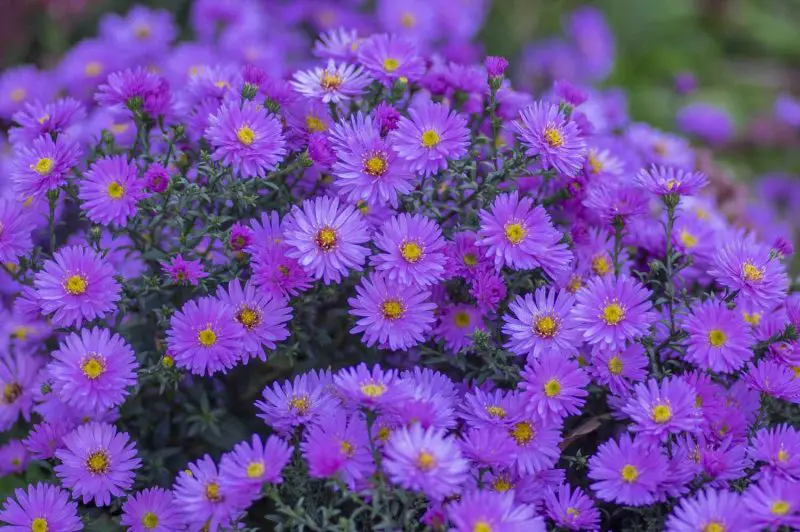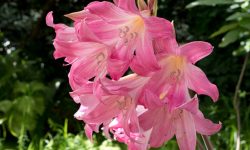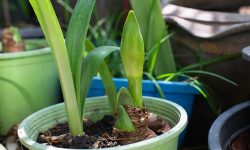Asters are vibrant flowers that bring dazzling color to gardens from late summer through fall. Planting at the right time not only ensures healthy growth but also guarantees consistent and long-lasting blooms. Careful timing helps the plants establish strong roots and thrive even in challenging weather conditions.
Understanding the best planting season, soil requirements, and care needs is key to achieving maximum color and flower production. This guide offers essential tips, from selecting the right varieties and preparing the soil to effective care techniques, helping you create a stunning garden full of asters that bloom continuously.
Understanding Aster Varieties

Garden Asters
Garden asters are tall, showy varieties that can reach several feet in height, making them ideal for background planting. They produce large, colorful blooms that attract pollinators like bees and butterflies, adding both visual appeal and ecological benefits to your garden. These asters prefer full sun and well-draining soil, and they perform best when spaced properly to allow airflow between plants. Choosing healthy, disease-resistant varieties ensures long-lasting blooms throughout the season.
Planting garden asters requires attention to soil fertility and consistent watering. Mulching around the base helps retain moisture and regulate temperature, promoting robust growth. Deadheading spent flowers encourages continuous blooming and prevents self-seeding. With proper care, garden asters become a centerpiece in the landscape, providing height, color, and seasonal interest from late summer into fall. Their dramatic flowers make them perfect for cutting gardens and mixed borders.
Dwarf and Border Asters
Dwarf and border asters are compact varieties that stay low to the ground, usually under two feet. Their small size makes them perfect for front-of-border planting, container gardens, and rock gardens. Despite their smaller stature, they produce abundant blooms that can brighten any garden space. These asters often thrive in partial shade and are easier to manage in terms of spacing and maintenance compared with taller varieties. Selecting varieties suited to your local climate ensures better flower performance and longer bloom duration.
These compact asters benefit from well-draining soil enriched with compost or organic matter. Regular watering and light fertilization encourage healthy growth and more vibrant flowers. Pruning and deadheading help maintain shape and promote continuous blooming throughout the season. Dwarf asters also work well as companion plants, creating colorful groundcover and complementing taller perennials. Their versatility and low maintenance make them ideal for small gardens or areas where space is limited.
Species-Specific Asters
Species-specific asters, such as New England asters or New York asters, have unique growth habits, bloom times, and color ranges. New England asters typically produce tall, vibrant purple or pink flowers and are hardy in cooler climates. New York asters tend to be shorter, with daisy-like flowers in shades of white, pink, or lavender, and they bloom slightly earlier. Knowing the specific traits of each species helps gardeners plan for continuous color and staggered bloom periods.
Planting species-specific asters requires understanding their preferred soil, sun, and moisture conditions. New England asters thrive in full sun and slightly acidic soil, while New York asters tolerate partial shade and diverse soil types. Proper spacing and care, including mulching and pest management, maximize bloom performance. By selecting species-specific asters, gardeners can create dynamic landscapes with layered colors, textures, and heights. Incorporating multiple species also attracts a wider range of pollinators and enhances biodiversity.
Soil Preparation for Asters
Healthy asters begin with well-prepared soil that provides nutrients, proper drainage, and a stable foundation. These flowers prefer loose, fertile soil that is rich in organic matter. Before planting, remove any weeds, rocks, or debris that could compete with young asters for nutrients. Incorporating compost, aged manure, or other organic amendments improves soil texture, promotes beneficial microbial activity, and enhances nutrient availability. A slightly acidic to neutral pH, ideally between 6.0 and 7.0, is optimal for most aster varieties. Conducting a soil test before planting helps determine whether additional amendments, such as lime or sulfur, are needed to balance pH.
For heavier clay soils, raised beds or mounded rows can improve drainage and prevent waterlogging, which may lead to root rot. Lightly tilling the soil ensures even distribution of organic matter and reduces compaction, allowing roots to establish quickly. Sandy soils benefit from added compost to retain moisture and nutrients. Proper soil preparation is essential not only for initial growth but also for long-term plant health. A well-prepared bed supports stronger roots, more vibrant foliage, and abundant, long-lasting blooms throughout the season.
Ideal Planting Time by Region
Timing is critical for asters to thrive and produce abundant blooms. In colder climates, the best time to plant asters is in early spring after the last frost. Planting during this period allows roots to establish and strengthens the plant before summer heat arrives. Early spring planting also gives asters enough time to develop healthy foliage and flower buds, ensuring vibrant blooms later in the season. Gardeners should monitor local frost dates and adjust planting schedules accordingly.
In milder regions, asters can be planted in late summer or early fall. Fall planting encourages root growth while temperatures are moderate, setting the stage for strong flowering in the next season. Avoid planting during extreme heat or prolonged drought, which can stress young plants and slow growth. Microclimates, such as shaded areas or wind-protected spots, may allow for slight adjustments in planting time.
Understanding regional conditions and choosing the correct planting window ensures optimal growth, reduces the need for intensive care, and maximizes flower production. With careful planning, asters will establish quickly, resist pests and disease, and produce long-lasting, colorful blooms that enhance your garden throughout the season.
Selecting Healthy Aster Plants
Choosing healthy aster plants is essential for establishing a vibrant, long-lasting garden. Look for plants with firm stems, vibrant green leaves, and no signs of wilting or yellowing. Avoid any specimens showing pest damage, fungal spots, or root rot. Inspect container-grown plants by gently removing them from the pot to examine roots; healthy roots are firm, white or light tan, and free of decay. Compact, bushy plants generally bloom earlier and produce more flowers than leggy or sparse specimens.
Bare-root asters require careful handling to avoid damaging delicate roots. Keep the roots moist until planting and soak them in water for a short period before placing them in the soil. Selecting disease-resistant varieties reduces the risk of powdery mildew and rust, common issues in asters. Healthy plants adapt quickly to new soil conditions, establish faster, and are more resilient to environmental stress.
Investing time in selecting quality asters pays off with better flower production, stronger stems, and longer bloom duration. Purchasing from reputable nurseries increases the chances of acquiring robust, pest-free plants. By prioritizing plant health from the start, gardeners set the stage for a colorful, thriving aster display that lasts throughout the season.
Proper Spacing and Planting Techniques
Spacing for Healthy Growth
Proper spacing is crucial to ensure asters grow strong and bloom abundantly. Crowded plants compete for sunlight, water, and nutrients, which can stunt growth and reduce flower production. Tall varieties generally require 24 to 36 inches between plants, while dwarf or border asters can be spaced 12 to 18 inches apart. Adequate spacing improves airflow, reducing the risk of fungal diseases such as powdery mildew. Observing plant height and growth habit before final placement helps prevent overcrowding as asters mature.
Planning spacing also allows for easy maintenance, including watering, fertilizing, and pruning. Proper distances between plants make it simpler to deadhead spent flowers and manage pests effectively. By paying attention to spacing, gardeners encourage stronger root systems, healthier foliage, and more vibrant blooms.
Planting Techniques for Success
Correct planting techniques complement proper spacing and support vigorous growth. Dig holes slightly larger than the root ball and place the plant at the same depth it grew in the container or nursery bed. Backfill with prepared soil, gently firming around roots to eliminate air pockets. Water thoroughly after planting to settle the soil and promote root establishment. Mulching around the base helps retain moisture, suppress weeds, and regulate soil temperature.
Avoid piling mulch directly on stems to prevent rot and disease. Pinching back young plants encourages branching, resulting in fuller growth and more flowers. Consistent care after planting, combined with proper spacing, ensures asters thrive and reach their maximum color potential. Well-executed planting sets the stage for long-lasting, abundant blooms throughout the season.
Watering Requirements for Maximum Bloom
Consistent and proper watering is essential for asters to thrive and produce vibrant, long-lasting flowers. Newly planted asters require regular moisture to help roots establish quickly. Water deeply, ensuring that water reaches the root zone, but avoid waterlogging, which can lead to root rot and other diseases. Mulching around the base of the plants helps retain soil moisture, regulate temperature, and reduce evaporation, supporting healthy growth during warm periods.
Established asters tolerate short dry spells but perform best with steady, moderate watering. Adjust frequency based on soil type, climate, and seasonal rainfall. Sandy soils may need more frequent watering, while clay soils retain moisture longer. Morning watering is ideal, allowing foliage to dry during the day and reducing the risk of fungal infections. Avoid watering late in the evening, which can create damp conditions that promote mildew and other diseases.
Proper watering encourages strong stems, lush foliage, and abundant flower production. Combined with fertilization and sunlight, regular watering directly impacts the number, size, and intensity of blooms. By monitoring soil moisture and adjusting watering routines, gardeners ensure their asters achieve maximum color and continuous flowering throughout the season.
Fertilization Tips for Healthy Growth
Providing proper nutrition is essential for asters to develop strong stems, lush foliage, and abundant flowers. At planting time, applying a balanced, slow-release fertilizer helps establish a solid foundation. Fertilizers high in phosphorus encourage root development and flower production, while excessive nitrogen can lead to leafy growth with fewer blooms. Organic options, such as compost, worm castings, or fish emulsion, supply nutrients gradually and improve soil structure, supporting long-term plant health.
During the growing season, light supplemental feeding promotes continuous flowering. Apply fertilizer evenly around the root zone and water thoroughly to prevent root burn. Avoid fertilizing too late in the season, as this may stimulate tender growth susceptible to frost damage. Regular soil testing can identify nutrient deficiencies and ensure the correct type and amount of fertilizer is used.
Consistent fertilization not only enhances bloom quantity and color but also strengthens plants against pests and disease. Well-nourished asters are more resilient, bloom longer, and maintain vibrant color throughout the season. By combining proper fertilization with watering, sunlight, and pruning, gardeners can achieve maximum flower performance and a healthy, thriving garden display.
Sunlight Requirements for Vibrant Color
Asters thrive in full sun, requiring at least six hours of direct sunlight daily to produce vibrant, abundant blooms. Adequate sunlight strengthens stems, encourages healthy foliage, and extends flowering periods. In partially shaded areas, asters may grow but typically produce fewer flowers and weaker stems. Gardeners should observe seasonal light patterns and choose planting locations that receive consistent sunlight throughout the day.
South-facing beds or open spaces are ideal for maximizing light exposure, while locations shaded by trees or buildings may need careful planning. Reflective surfaces, such as walls or light-colored fences, can increase sunlight in slightly shaded areas. Proper sun placement enhances flower color intensity and encourages natural growth rhythms, helping asters resist pests and environmental stress.
Balancing sunlight with watering, soil fertility, and spacing is key to achieving peak bloom performance. Insufficient light can lead to leggy growth and pale flowers, while full sun promotes dense, vibrant blooms. By selecting optimal planting sites and monitoring sun exposure, gardeners ensure asters reach their full color potential, creating eye-catching, long-lasting displays throughout the season.
Pest and Disease Management
Preventing Common Diseases
Asters are prone to fungal diseases like powdery mildew, rust, and leaf spot. Preventing these problems begins with proper planting and maintenance. Adequate spacing between plants improves airflow and reduces humidity around leaves, limiting fungal growth. Choosing disease-resistant varieties provides additional protection. Mulching around the base helps prevent soil-borne pathogens from splashing onto foliage during watering or rain.
Watering practices also play a crucial role in disease prevention. Avoid overhead watering late in the day, as wet foliage overnight encourages fungal infections. Morning watering allows leaves to dry quickly and reduces disease risk. Regularly inspecting plants for early signs of disease, such as spots or discoloration, allows for timely intervention before problems spread. Removing infected leaves promptly keeps the rest of the plant healthy and maintains overall garden appearance.
Managing Pests Effectively
Asters can attract pests such as aphids, spider mites, and caterpillars. Early detection and monitoring are essential for effective control. Inspect leaves, stems, and flower buds regularly for signs of damage or infestations. Encouraging beneficial insects like ladybugs and lacewings can naturally reduce pest populations.
Organic sprays, such as neem oil or insecticidal soap, are effective for minor infestations without harming pollinators. Avoid applying chemical pesticides indiscriminately, as this can disrupt beneficial insect populations and reduce plant resilience. Maintaining plant health through proper watering, fertilization, and pruning strengthens asters against pest attacks. Timely management ensures flowers remain vibrant and abundant throughout the season, contributing to a healthy, thriving garden.
Pruning and Deadheading for Continuous Bloom
Deadheading to Encourage New Flowers
Deadheading spent blooms is essential to maintain continuous flowering in asters. Removing faded flowers redirects the plant’s energy from seed production to new bud development. Use clean, sharp garden shears to snip flowers just above the first set of healthy leaves, avoiding damage to stems. Regular deadheading throughout the blooming season promotes a fuller, more vibrant display of flowers.
This practice also helps improve overall garden aesthetics by preventing wilting blooms from lingering. By encouraging new growth, deadheading extends the flowering period, ensuring asters provide color well into fall. Combined with proper spacing, watering, and fertilization, consistent deadheading maximizes flower production and enhances plant health. Observing your plants weekly allows you to remove spent blooms promptly, keeping asters attractive and thriving.
Pruning for Plant Health and Shape
Pruning asters helps maintain their shape, promotes bushier growth, and reduces the risk of fungal disease. Pinching back young plants early in the season encourages multiple stems, leading to more flowers per plant. Light pruning of leggy or overgrown stems improves airflow, decreasing humidity that favors mildew or rust.
Pruning should be done carefully, avoiding removal of too much foliage at once. Late-season pruning after the first frost helps prepare plants for winter while protecting root systems. Proper pruning, combined with deadheading, ensures asters remain compact, healthy, and highly productive. These techniques are crucial for gardeners seeking continuous, vibrant blooms and a visually appealing landscape throughout the growing season.
Companion Planting with Asters
Companion planting enhances both the beauty and health of aster gardens. Choosing plants with similar sunlight, soil, and watering requirements ensures that all species thrive together. Flowers such as coneflowers, sedums, and ornamental grasses pair well with asters, creating layers of color, texture, and height. These combinations not only boost visual appeal but also attract pollinators like bees and butterflies, supporting garden biodiversity.
Low-growing companions can act as ground cover, retaining soil moisture and suppressing weeds around asters. Taller plants provide partial shade for more delicate varieties, protecting them from excessive heat. Consider bloom timing to maintain a continuous display of flowers from early summer through fall. Avoid planting asters near aggressive species that compete for nutrients, as overcrowding can reduce bloom quality and plant vigor.
By strategically planning companion plants, gardeners can create harmonious and dynamic landscapes. Proper placement encourages healthy growth, reduces pest pressure, and enhances soil quality. Combining asters with complementary plants results in a resilient, thriving garden full of vibrant, long-lasting color. Thoughtful companion planting maximizes the aesthetic impact while supporting a balanced, sustainable ecosystem.
Overwintering Asters for Next Season
Proper care after blooming is crucial to ensure asters return strong and healthy the following year. After the first frost, cut back stems to just a few inches above the ground to prevent disease and make space for new growth in spring. Removing old foliage helps reduce overwintering pests and fungal spores. Applying a thick layer of mulch, such as straw, leaves, or shredded bark, insulates roots from freezing temperatures and fluctuating soil conditions.
In colder climates, additional protection may be necessary. Covering beds with extra mulch or using frost blankets shields the plants from extreme cold and harsh winds. For container-grown asters, moving pots to a sheltered, unheated area such as a garage or basement can prevent root damage. Avoid disturbing roots during winter, as this can stress plants and slow spring growth.
Proper overwintering not only preserves plant health but also encourages earlier and more abundant blooms in the next season. By preparing asters for winter, gardeners can enjoy consistent color year after year. With careful protection and minimal maintenance, overwintered asters emerge vigorous, resilient, and ready to produce vibrant flowers, making them a reliable feature in any garden.
FAQ About When to Plant Asters
When is the best time to plant asters?
The best time depends on your local climate. In colder regions, early spring after the last frost is ideal, giving roots time to establish before summer heat. In milder climates, late summer or early fall works well, allowing asters to develop strong roots before winter. Timing affects bloom quality, so monitor frost dates and adjust planting accordingly.
How much sunlight do asters need?
Asters require at least six hours of direct sunlight daily to thrive. Full sun promotes strong stems, vibrant foliage, and abundant blooms. Partial shade is possible, but plants may become leggy, produce fewer flowers, and have weaker stems. Choosing a sunny location ensures maximum color and long-lasting blooms throughout the season.
How often should I water asters?
Newly planted asters need consistent watering to establish roots, typically every 2–3 days depending on soil and weather. Once established, they prefer deep, moderate watering about once a week. Adjust frequency based on rainfall, soil type, and temperature. Overwatering can cause root rot, while underwatering can reduce flower production and overall plant health.
How do I prevent common aster diseases?
Prevent fungal diseases by ensuring proper spacing for airflow and avoiding overhead watering late in the day. Remove any infected or discolored leaves immediately. Selecting disease-resistant varieties reduces the risk of powdery mildew and rust. Mulching around the base helps prevent soil-borne pathogens from reaching foliage. Proper care and monitoring keep plants healthy and blooming longer.
Can asters survive winter, and how should I prepare them?
Most asters are hardy perennials and can survive winter with proper care. After the first frost, cut back stems to a few inches above the soil and remove dead foliage to prevent pests and disease. Apply a thick layer of mulch to insulate roots. For container-grown asters, move pots to a cool, frost-free area. Proper winter preparation ensures vigorous growth and abundant blooms the following season.
Conclusion: Achieving Maximum Color and Bloom
Planting asters at the right time, with proper soil, sunlight, and care, ensures abundant flowers and vibrant color. Understanding varieties, regional timing, and cultural requirements maximizes success. Healthy plants, correct spacing, and regular maintenance reduce disease and pest problems. Fertilization, watering, and pruning encourage strong growth and continuous blooming. Companion planting and seasonal adjustments enhance garden aesthetics and ecological balance. Overwintering properly guarantees future blooms and sustained beauty. By following these essential tips, gardeners can enjoy long-lasting, colorful aster displays. Careful planning and attention to detail create a rewarding gardening experience. With knowledge and patience, asters can provide consistent, eye-catching blooms for seasons to come.






